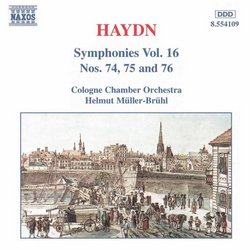| All Artists: Franz Joseph Haydn, Helmut Müller-Brühl, Cologne Chamber Orchestra Title: Haydn: Symphonies Nos. 74-76 Members Wishing: 1 Total Copies: 0 Label: Naxos Release Date: 10/18/2002 Genre: Classical Styles: Historical Periods, Classical (c.1770-1830), Symphonies Number of Discs: 1 SwapaCD Credits: 1 UPC: 636943410929 |
Search - Franz Joseph Haydn, Helmut Müller-Brühl, Cologne Chamber Orchestra :: Haydn: Symphonies Nos. 74-76
 | Franz Joseph Haydn, Helmut Müller-Brühl, Cologne Chamber Orchestra Haydn: Symphonies Nos. 74-76 Genre: Classical
|
Larger Image |
CD DetailsSimilar CDs
|
CD ReviewsExploring the Haydn Symphonies -- Nos. 74.75, and 76 Robin Friedman | Washington, D.C. United States | 01/24/2005 (4 out of 5 stars) "While thinking about Haydn and this recording, I came across an article by Terry Teachout in the January, 2005 issue of "Commentary" titled simply "Haydn!". Teachout observes how Haydn's works remain more admired than heard. He praises Haydn for his sense of seriousness without being somber, for his humor, cheerfulness, and classic balance, for his inventiveness and creativity, and for the size and high quality of his compositional output. Unlike many other artists, Haydn, Teachout argues, was a person comfortable with himself and with life. He did not take himself too seriously and did not exhibit the artisic temperament which became beloved of the romantics. Instead, Haydn worked inobtrusively and steadily over the years with an increasing sense of growth and sureness. In a quiet, workmanlike way, he produced a body of great music. We are fortunate today that Haydn's symphonies have been recorded in detail and are available for the interested music-lover. Among the most accessible of these recordings are those on the budget-priced Naxos label by a variety of ensembles and conductors. The recording I am discussing here features the Cologne Chamber Orchestra conducted by Helmut Muller-Bruhl. These recordings make it possible for the interested listener to sample some of Haydn's symphonies, beyond the familiar works or to explore them in detail. The symphonies will not disappoint and will bring musical pleasure and knowledge at every level of experience. Haydn's "70's" symphonies lie between the earlier storm and stress symphonies and his subsequent Paris and London symphonies. They show stock-taking, consolidation, consistency, and an increasing growth of musical power. The symphony no. 74 in E flat major which opens this CD was probably composed in 1780. The opening vivace assai begins with with three large chords followed by a flowing main theme and a lyrical second theme with short phrases and pregnant pauses. There is an extensive development which passes into the minor key just before the return of the main themes. The second movement, adagio cantabile, is a set of variations on a theme first stated in the violin over an accompaniment in the cello. The theme is embroidered by different groups of instruments, including a lovely moment for flute, bassoon, and oboe. The minuets on this CD are generally taken rather slowly. This symphony features a quiet minuet with a dancelike theme giving emphasis to the bassoon in the trio. The finale, allegro assai, is a quiet, lively and humorous movement, with a variety of rhythms and featuring themes of different lengths and note values. It has something of a quizzical character. The symphony no. 75 in D major, also composed in 1780, opens with a dramatic slow introduction marked "Grave" followed by a dashing, rapid theme punctuated by tympani. This movement reminded me of Mozart's Don Giovanni overture, which shares a similar structure and is also in the key of D. The second movement, poco adagio, features the horns and again consists of a set of four variations for different combinations of instruments. The third variation in particular is given over to a beautiful solo for cello. The minuet for this symphony is stately and stated in the lower register with a contrasting trio for the winds in a higher register. The finale is a rondo with a light, quiet theme and two markedly contrasting episodes. The final symphony of this CD, No. 76 in E flat major was composed for a proposed trip to London that did not materialize until ten years later. The opening allegro is dominated by the initial theme forcefully stated in the strings which builds throughout the movement. The second movement is an extensive adagio ma non troppo which contrasts a quiet, lyrical theme with a dramatic, angular theme in the minor. Both themes are developed and varied as the movement progresses. The third movement is the minuet, which again is taken slowly here. It is tinged with melancholy after the intensity of the slow movement. The trio is a little dance in the strings. The finale, allegro, ma non troppo, is a delight. The main theme of this movement is a graceful, lyrical melody stated in the violin followed by a full orchestral statement. There is a wonderful descending figure in the cellos as the movement progresses, and the symphony comes to an uptempo, joyous close. This CD will bring the joy and inventiveness of Haydn to the receptive listener." Good musical value DWPC | Ventura, CA United States | 08/04/2003 (3 out of 5 stars) "Three of Haydn's most pleasant, if not most note-worthy, symphonies are ably performed on this CD. This disk is an excellent choice for the casual listener who enjoys Haydn's style, but a really serious Haydn fan would probably search further. Typical Naxos competance in the recording quality."
|

 Track Listings (12) - Disc #1
Track Listings (12) - Disc #1

